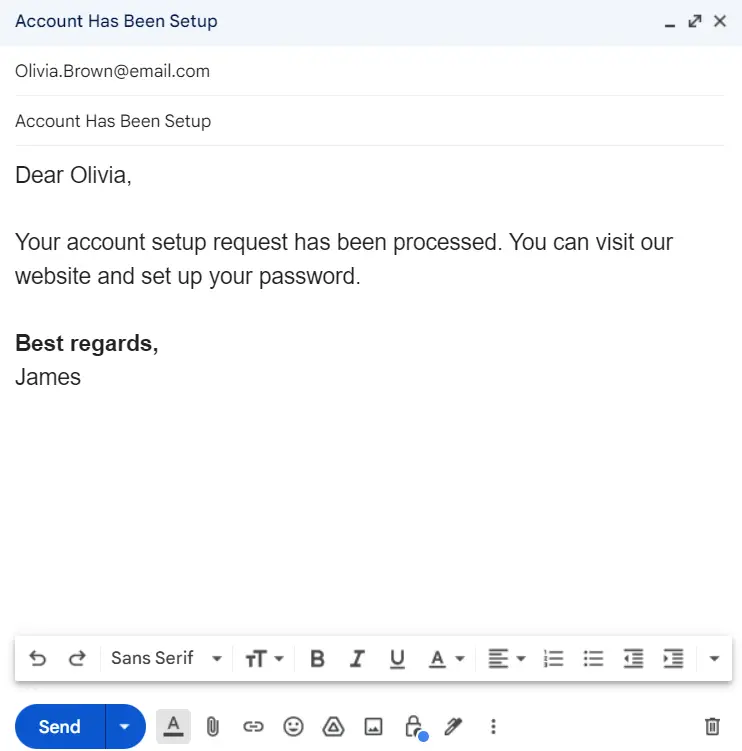This article is a great resource if you are seeking to end an email professionally. It provides a variety of ways how to end an email, depending on the content of the email and the person you’re writing to.
If you want to know what some bad ways to end an email are then this article will also help you with that.
How to End an Email Professionally?
When you work in a co-op there is a certain ethic to writing emails. When you write an email you should have a salutation such as Hi, Good morning, etc., a body of the email, a sign-off, and a signature. Below you will find a detailed explanation of the different closing phrases. And you can check out the best options to start an email in this article.
10 Professional Ways to End an Email
These sign-offs should be used in every email you send to show respect for the other party and good business ethics.
1. Best regards
Best regards is the most commonly used sign-off. It is often sent to colleagues, managers, and customers.
2. Kind regards
It’s also very often used in the workplace. You can find more details about this closing phrase here.
3. Sincerely yours
“Sincerely yours” is more formal than “Sincerely” and both sign-offs are more used in the USA. Here you can find more information about how to use Sincerely in email.
4. Warm regards
It shows more sensuality, which is not good to use in more formal correspondences.
5. Faithfully yours
The use of “Faithfully yours” is more common in British English than American English.
6. Yours truly
‘‘Yours truly” is often used in formal letters to insignificant acquaintances.
7. Yours respectfully
“Yours respectfully” is used to a person that you have seen.
8. Best wishes
Rather, it can be used between friends, colleagues or acquaintances.
9. With gratitude
If a sign-off is not used, the last sentence should be a thank you or acknowledgment of the reader.
With gratitude,
Your Name
10. Regards
The least official of those listed above. Most commonly used in email correspondence with a colleague.
10 Formal Expressions to Close an Email
The sign-offs listed above are required for each of your emails, and you can use these to show more professional business ethics.
1. Please feel free to contact me if you need any further information.
2. Thank you in advance for your cooperation!
3. I’m looking forward to your reply.
4. Have a pleasant and successful day!
5. I hope you have a great weekend.
6. I hope the information above is useful to you.
7. It was a pleasure for me to assist you with this.
8. Thank you for your business and the opportunity to serve your needs.
9. Thank you for your patience and understanding.
10. Have a wonderful day and an enjoyable weekend.
10 Informal Ways to End an Email
1. Let me know if you need anything else.
2. Have a great vacation!
3. Thank you!
4. Have a sunny day!
5. Let me know how else I can help.
6. Have a nice week ahead!
7. Looking forward to hearing from you.
8. Enjoy your weekend!
9. Please do not hesitate to contact us.
10. Talk to you soon!
Where Are Sign-offs Placed in the Email?
You need to place your sign-off directly before your name. Your sign-off should be written in the same style/font as the rest of the email.
Example:
Hi,
(email body)
Kind regards,
Sarah
Do I Have to Put a Sign-off in Every Email?
It depends on who you are emailing and how often. If you’re emailing with a client it’s a must, but if you’re emailing with a colleague or supervisor and you’re discussing a topic with lots of accompanying emails it’s not as vital.
American and British English Closing Phrases
In American English, the most common closing phrase is “Best”. It can be used in both informal and formal communication. In British English, the most common closing phrase is “Cheers” which is more casual than the American counterpart.
It is important to note that people use “Yours sincerely” in British English as a closing phrase but in American English is more likely to see “Sincerely yours”.
Which Closings Are More Formal?
• Respectfully
• Faithfully
• Truly yours
• Sincerely yours
Which Closings Are More Casual?
• Thanks
• Cheers
• Best
• Warmly
Sample Email Using Sign-off

Abbreviations
Kind regards – KR
Best regards – BR
Thanks – Thx
Regards – Rgds
Yours Sincerely – YS
Yours Truly – YT
When writing a formal professional email you should avoid using these abbreviations. Abbreviations are short for words, and often have a different meaning than the word itself. Using abbreviations in an email can cause confusion between the writer and the receiver of the message. For example, “BR” could stand for “Business Result” and also for “Best Regards”.
Which Sign-offs to Avoid?
• With love
• Take care
• Love
• Talk soon
• See you
When writing a professional email you should not use words that express any kind of sensuality. You should demonstrate a high level of professionalism.









